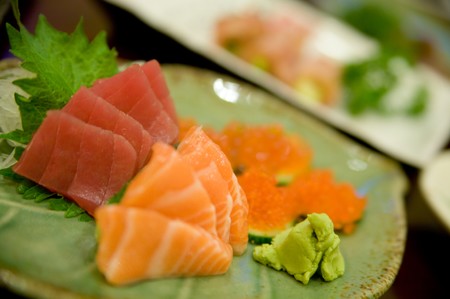The Raw on Japanese Dining

In a country whose roots lie in mental and physical awareness, art, and respect, Japan’s food is a spitting image in representation of their culture. Fresh, raw ingredients paired with an excellent balance of flavors and Guggenheim-worthy presentations lay the base for an array of wild, exotic, and naturally delicious ingredients. To top it all off is a fantastic blend of long-standing techniques and culinary history. With everything from ramen and fish cakes to fermented soybeans and wild, rare sea creatures, the world of Japanese cuisine is quite larger than most people think.
The best way to understand a culture is to look at the ingredients the people cook with. Do they hold animals sacred and utilize every part? Do they only use the good pieces and trash the rest? Well, Japanese cooking uses unique ingredients others would never think of. Raw sea urchin, for example, is literally surrounded by spikes. Most would not think to carefully remove the spiny defense and try whatever creature is inside, but it has become a staple in Japanese cuisine.
The Japanese also thought to ferment soybeans, which has become a delicacy referred to as natto or miso, and is used in most dishes. Rice, shrimp, and various other chili pastes are used to season dishes as well. Japanese chefs also like to utilize various noodles including udon, soba, ramen, and somen noodles; and traditionally, rice is served along with every single meal. Japan is a very big consumer of fish, although not all of it is eaten raw; various other methods include poaching, steaming, and pan searing. Kobe beef is now a world-famous type of high quality beef only found in Japan. As is common in the culinary world, all meals are served with local seasonal vegetables, often cooked with garlic, soy sauce, fish sauce, ginger, chilis or various other ingredients depending on the meal.
While many Americans think of Japanese food as consisting of teriyaki bowls, California rolls, and pretty much anything that is served with chopsticks, the true dishes are much more unique and diverse. Common home-style cooking, Washoku, involves simplistic meals that include miso, rice and fish or any number of noodle-type dishes that are usually served with seafood broth made with shrimp and dried kale. There is a very popular modern gastronomical scene in Japan that focuses on rare ingredients and meals, which typically will become events lasting for hours on end. The “bar food” of Japan, known as Izakaya, is typically tapas-style and will generally consist of various skewers of grilled meats known as yakitori and thick slices of fresh sashimi eaten right at the bar with a nice sake. Of course multiple variations exist, particularly as the style spread to the West, and have evolved into a number of intriguing and intricate dishes. While they don’t always represent true Japanese style, they can still be delicious and pleasing to eat.
Different sushi bars all have signature rolls, usually catering to the chosen theme of the bar; Japanese flavors have been utilized in BBQ’s, fondue restaurants, and burger joints as well. Sukiyaki is a popular dish where the chef cooks in front of the guests on a habachi grill, and has grown quite popular in the West. Big event joints like Sakura and Benihana have become popular Japanese establishments and bring the idea of tableside cooking to a whole new level. This is often geared towards tourists and those not looking for traditional Japanese fare. However, no type of Japanese fusion or distortion is any match for the traditional styles where techniques are mastered and have been passed down from generation and generation.
Intricate knife work, wicked sharp blades, precise execution, and skilled hands are what make true Japanese food so pristine. The school of thought of Japanese cooking always stresses methods before recipes so that dishes can not only be repeated, but built on and adapted as well. Sushi is a popular type of food implementing these methods and typically involves rice and seaweed rolled around any number of types of fish, vegetables, or other concoctions. These ingredients can range from something cool and refreshing, like cream cheese, to something bold and original, like mango. Another popular type of cuisine is Shabu Shabu, a type of Japanese fondue with thin slices of beef, chicken and seafood cooked in a variety of flavored broths.
Hopefully this article provided you with some background understanding of the intricacies and various styles of traditional Japanese cooking. Next time you go to get Japanese food, you will be a little more knowledgeable about what you’re ordering and might even have the courage to try something you never had before. The culinary world is an ever-changing one and is often a fusion of multiple regional traditions, so it is important to understand where the original traditions come from before you can fully understand modern culinary customs.
Copyright TableAgent.com
© Restaurant Agent Inc.